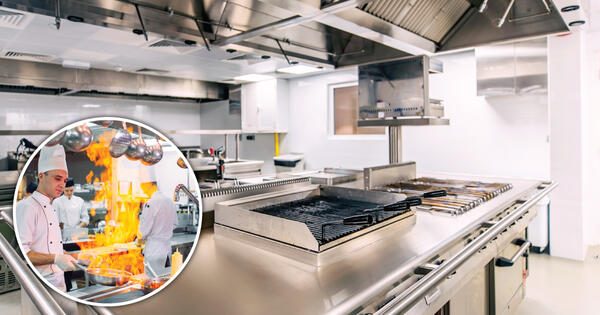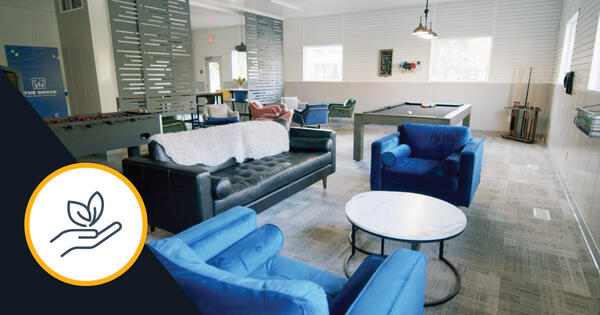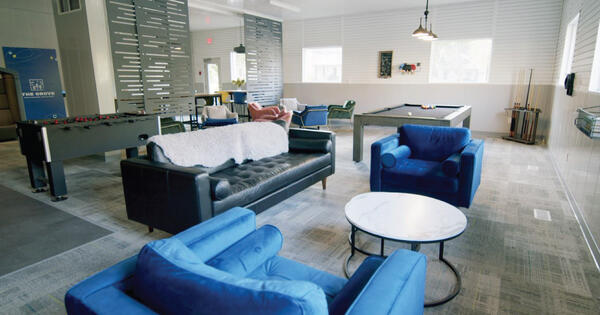The materials you choose to install on commercial kitchen walls play a pivotal role in maintaining hygiene, ensuring safety, and adhering to regulatory standards. In this blog post, we analyze three popular materials in commercial kitchens to help you ensure the walls in your space can withstand the heat, moisture, and rigorous demands of a bustling culinary environment.
Commercial Kitchen Wall Regulations and Standards
Before we delve into the nitty-gritty of material selection, let's get the groundwork right. Architects and contractors must navigate a maze of health and safety regulations when designing commercial kitchens. Here's a concise list of the standards that govern commercial kitchen construction:
- Local Health Department Regulations: Local health departments set the foundation for kitchen design standards. These regulations cover everything from wall materials to sanitation practices, ensuring that kitchens meet specific health and safety requirements.
- National Fire Protection Association (NFPA) Standards: The NFPA's codes and standards, such as NFPA 96 for ventilation control and fire protection of commercial cooking operations, are essential for fire safety in commercial kitchens.
- Food and Drug Administration (FDA) Guidelines: The FDA provides guidance on safe food handling and storage, which indirectly affects wall material choices by emphasizing cleanliness and hygiene.
- Canadian Food Inspection Agency (CFIA) Guidelines: The CFIA is a federal agency of the Government of Canada that is responsible for safeguarding food, animals, and plants. The CFIA plays a critical role in ensuring the safety and quality of Canada's food supply and agricultural products.
- National Sanitation Foundation (NSF) Certification: NSF certification signifies that a product meets strict public health standards. When selecting materials, look for those with NSF certifications to ensure they're safe for use in commercial kitchens.
- International Building Code (IBC): The IBC outlines structural and fire safety requirements, including wall construction, to ensure the overall safety of commercial buildings.
These regulations provide a comprehensive framework for ensuring that commercial kitchens are safe and hygienic. It's crucial to understand and adhere to these standards to avoid costly revisions and potential health hazards down the line.
Commercial Kitchen Wall Material Selection Criteria
Now, let's talk about the factors that should drive your material selection process. When choosing materials for commercial kitchen walls, architects and contractors need to consider several key criteria:
- Durability: Commercial kitchen walls endure constant traffic and physical stress, which means it requires materials that can withstand constant use and abuse. Opt for materials that can withstand the daily wear and tear, maintaining their integrity over time.
- Hygiene: In an environment where food safety is non-negotiable, materials must uphold the highest standards of hygiene. Opt for food safety compliant kitchen walls that are non-porous and resistant to bacterial growth.
- Ease of Cleaning: Regular cleaning and disinfection are central to maintaining a sanitary kitchen. Materials should feature surfaces that are easy to clean and disinfect, reducing the risk of contamination.
- Installation: The ease and efficiency of installation are practical considerations. Some materials may require specialized labor or intricate installation processes, potentially impacting project timelines and costs.
- Fire Performance: Fire safety is a crucial concern, especially in areas with open flames and high temperatures. Materials should either be inherently fire-resistant or incorporate fire-resistant properties to meet safety standards.
- Cost: While quality is essential, cost considerations play a significant role in material selection. Balancing quality materials with budget constraints is important.
3 Kitchen Wall Materials for Commercial Use
With these criteria and characteristics in mind, let’s take a detailed look at the performance of three common commercial kitchen wall materials: stainless steel, fiberglass reinforced plastic (FRP), and polyvinyl chloride (PVC) panels.

1. Stainless Steel Wall Panels
Stainless steel is a hygienic and easy to clean option for commercial kitchens. Its benefits include:
- Durability: Stainless steel wall panels are highly durable and are resistant to corrosion, rust, and stains. They can withstand normal wear and tear (such as contact with utensils, pots, and pans), exposure to high temperatures, and they won't deteriorate when exposed to water and cleaning chemicals.
- Hygiene: Stainless steel is non-porous, meaning it won’t absorb liquids, grease, bacteria, or odors.
- Cleanability: Stainless steel panels are easy to clean and wipe down. Panels don’t have seams, joints, and grout lines, which reduces the risk of food particles and bacteria getting trapped and ensures you get everything with a single wipe. However, you can damage the panels if you use abrasive or high-strength cleaning supplies.
- Installation: Stainless steel wall panels require a multi-step installation process. First, you must ensure that the wall surface is clean, dry, and free from debris or contaminants. You have to take accurate measurements and transfer them onto the panels before marking your cut lines and cutting them to size. Then, you have to install mounting hardware (like brackets, furring strips, or adhesive anchors) to the wall to secure the panels to the surface. If the manufacturer recommends using adhesive, you need to apply it to the panels or the wall, too. And that’s all before you ever place a panel on the wall.
- Fire Performance: Stainless steel itself doesn’t have a specific fire rating because it’s not a fire-rated material like other building materials. However, stainless steel is popularly used in construction and commercial kitchen applications because it has a high melting point, doesn’t readily catch fire, and doesn’t support combustion.
- Cost: The price of stainless steel wall panels depends on the supplier, quality, size, and installation requirements. However, stainless steel wall panels are generally more expensive than alternatives like FRP and PVC wall panels because metal is expensive, and the manufacturing process is lengthy and complex.

2. FRP Panels
FRP panels are a high-strength commercial kitchen wall material and have a few other characteristics to consider:
- Durability: FRP was originally designed for the aerospace, automotive, and marine industries, which required a special level of strength from their wall panels. As a result, they’re highly durable and will withstand any contact inside a commercial kitchen.
- Hygiene: While it’s billed as being completely moisture and water resistant, but the panel seams are penetrable. Over time, moisture can cause the plastic to separate from its substrate, creating a space for mold and mildew to grow.
- Cleanability: FRP can be cleaned with soap and water, disinfectants, and can be repeatedly pressure washed. However, like with stainless steel, stronger cleaners can damage the panels.
- Installation: FRP is difficult to handle, difficult to cut, and requires a multi-step installation process — including the use of backer messy glue — that calls for multiple skilled installers.
- Fire Performance: FRP has a range of fire ratings from Class C to Class A, with most panels generally featuring a Class C fire rating.
- Cost: While FRP materials like the panels, backer board, and adhesive are relatively affordable, you’ll spend more on installation. Since it’s a multi-step FRP often takes multiple skilled laborers to ensure it’s installed properly and since it’s a multi-step installation process, it will take hours or days to install. Over time, the hourly rate is sure to put a dent in your bottom line.

PVC Panels
PVC wall panels like Trusscore Wall&CeilingBoard are a high-performing and practical choice that ticks many boxes for commercial kitchens:
- Durability: The mechanical strength of PVC combined with the unique truss and ½" design of Trusscore Wall&CeilingBoard means that the panels can outlive the kitchens they’re installed in. The abrasion resistance of PVC also means that the panels are impact-resistant and can stand up to contact without showing dents, cracks, or damage.
- Hygiene: Trusscore panels also have a smooth, non-porous finish that makes it tough for bacteria, mold, or viruses to take hold, and they’re 100% moisture and water resistant. This means steam and humidity from cooking will never be an issue, and the panels can withstand repeated soaking during cleaning without growing mold or mildew.
- Cleanability: Whether it’s spilled sauce or oil splatter, you can easily and repeatedly wipe down Trusscore Wall&CeilingBoard with soap and water, disinfectants, sanitizers, and chemical cleaners. The smooth surface of Trusscore commercial kitchen washable wall panels is also stain resistant, so they will always look as good as the day they were installed.
- Installation: Trusscore Wall&CeilingBoard doesn’t require mounting hardware or adhesives to install. Panels can be installed directly on top of studs or over existing wall material like drywall or FRP. And the lightweight panels also have a tongue and groove interlocking system and pre-punched screw flange so that they can be installed quickly with only one person needed for the job.
- Fire Performance: Trusscore Wall&CeilingBoard has a Class A fire rating — the highest possible rating — with a flame spread index of 10 and smoke developed index of 380 per ASTM E84.
- Cost: Since Trusscore requires no special tools or skills to install, the pre-finished panels can be installed twice as fast with only one person needed for the job. Factor in material and labor, and Trusscore Wall&CeilingBoard offers a 33% lower installed cost compared to FRP.
While walls may not always be in the limelight, they form the backbone of a safe, hygienic, and functional kitchen space. Architects and contractors must prioritize materials that align with stringent requirements for hygiene, safety, and durability. By making well-informed choices, we can create commercial kitchens that meet and exceed industry standards.
Ready to specify Trusscore Wall&CeilingBoard in your next commercial kitchen? Find a commercial dealer today.






